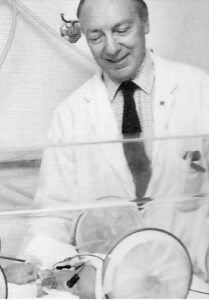Paul Robert Swyer, MD

Dr. Paul Swyer was born May 21st, 1921, in London England. He attended Bedford School and then Cambridge University, graduating with a medical degree in 1943. He then entered into the military and landed in France in June, 1944, working as a medical officer with the advancing Allied troops. He met the love of his life, Fernande, at a liberation ball in Belgium in 1944. They were married in June, 1947.
After the war, Swyer specialized in pediatrics at the Hospital for Sick Children, Great Ormond Street, London, and then emigrated to Canada in 1952, where he joined the Hospital for Sick Children in Toronto. He set up the first intensive care unit for sick newborns in 1961. “At SickKids, the first newborn intensive care unit was established in 1961—and was a single cubicle. This novel unit used research equipment to monitor infant respiration, inspired oxygen concentration, electrocardiogram, blood pressure, and core, skin and environmental temperatures.”(1) Swyer wrote:
“The necessity to monitor and control closely the infant’s vital signs, physiopathological status and environmental parameters during mechanical ventilation mandated an entirely new way of caring for the severely ill infant, designated (Neonatal) Intensive Care, analogous to the Coronary Care Intensive Care Units developing contemporaneously in adult hospitals.”(2)
Working with one of his fellows, Maria Delivoria-Papadopoulos, he pioneered the use of positive pressure mechanical ventilation for newborns with RDS, first publishing their results in the Archives of Disease in Children in 1964. (3) According to Swyer, the first ventilator used for newborns at SickKids was the positive pressure adult bird ventilator, fitted with the infant Q-Circle, designed by Sydney Segal (MD, Vancouver, 1920–1997) to reduce dead space ventilation.
Dr. Swyer’s career was full of accomplishments, including the introduction of portex tubes for intubation of newborns, developing a respiratory computer to study the mechanics of breathing, designing various oro-nasal masks, chairing the first symposium on artificial ventilation in the newborn, co-founding the international perinatal collegium, establishing one of the first newborn transport systems in Canada, performing early nutritional studies that led to our modern practices of oral and intravenous nutrition for sick and premature newborns. He received many awards, including fellowship in the Royal College of Physicians of London and a Doctorate in Medicine from University of Cambridge in 1984.
Reflecting on the early days of his career, he said, “The babies were dying of respiratory failure and starvation. The difference is that nowadays they die of more intractable infection or prematurity or complications, whereas then they were dying of relatively simple and treatable problems.”
“Things are changing—initially, we worked to get the basics in place. Now, the details are being filled in. What we did was try to clarify the neonatal pathophysiology—what was going wrong with breathing, for example and try to remedy it. Now it is getting very sophisticated and specific. It is all very important, but in the beginning there just was not time for that. We had greater urgency—the babies were dying. The fact of the matter was—the mortality for the 1000 g baby was 90% when I started. It was 10% when I retired.” (1)
Dr. Swyer retired at the age of 65, as required by the hospital, but continued to be active in research and professional societies, playing tennis regularly until his 90th birthday. He passed away at home on July 8, 2019.
(1) Reese, CN and Reese, J: Reflections on the early years of Neonatology. Paul R. Swyer: the beginnings of Canadian Neonatology at The Hospital for Sick Children in Toronto and Insights into his Early Career. Journal of Perinatology 38:297-305, 2018.
(2) Swyer PR. Babies. The Fight for Intact Survival at the Hospital for Sick Children, Toronto. 1875-2000. A Personal View.; 2004.
(3) Delivoria-Papadopoulos M, Swyer PR. Assisted ventilation in terminal hyaline membrane disease. Arch Dis Child. 1964;39:481–4.
Last Updated on 02/24/24